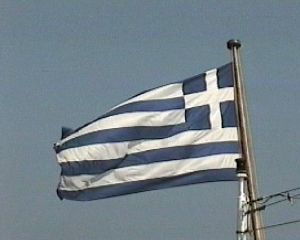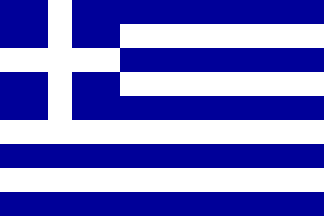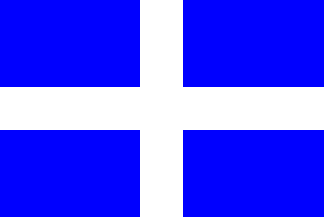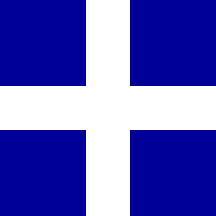 |
| Origins THE FLAG OF GREECE
The pattern and colors of the Greek Flag haven't changed a lot since the Revolution of the Greek Nation in 1821. Many people wonder why the founders of the Hellenic Democracy have chosen the symbols, patterns and colors that appear on the National Flag of Greece. It is difficult to reveal the true intentions of the people responsible for the selection of the flag. THE DESIGN AND PATTENS OF THE FLAG The striped flag has been in use since 1822, and was approved in 1833. The nine stripes are said to stand for the nine syllables of the Greek patriots' motto "Eleutheria e Thanatos" meaning "Freedom or Death".
FREEDOM OR DEATH Freedom or Death" was the motto during the years of the Hellenic Revolution against the Ottoman Empire in the 19th century [There are claims that the number of lines reflects the number of letters in the greek word for Freedom which equals 9]. This word stirred the heart of the oppressed Greeks, it created intense emotions and inspired them to fight and gain their freedom after 400 years of slavery. The line pattern was chosen because of their similarity with the wavy sea that surounds the shores of Greece.The interchange of blue and white colors makes the Hellenic Flag on a windy day to look like the Aegean Pelagos (Aegean Sea). Only the quaint islands are missing!
The Greek Square Cross that rests on the upper left-side of the flag and occupies one fourth of the total area demonstrates the respect and the devotion the Greek people have for the Greek Orthodox Church and signifies the important role of Christianity in the formation of the modern Hellenic Nation. During the dark years of the Ottoman rule, the Greek Orthodox Church helped the enslaved Greeks to retain their cultural characteristics: the Greek language, the Byzantine religion and generally the Greek ethnic identity, by the institution of the Crypha Scholia (hidden schools). The Crypha Scholia were a web of schools that operated secretly throughout Greece and were committed in transmitting to the Greeks the wonders of their ancestors and the rest of their cultural heritage. Today, Christianity is still the dominant religion among Greeks. Therefore the existence of the Cross is justified. THE COLORS OF THE FLAG Blue and White! These two colors symbolize the blue of the Greek sea and the whiteness of the restless Greek waves! According to the mythic legends, the Goddess of Beauty, Aphrodite emerged from these waves. In addition, it reflects the blue of the Greek sky and the white of the few clouds that travel in it. There are some who suggest that the blue and white symbolizes the similar color of the clothing (vrakes) of the Greek sailors during the Greek War of Independence. Technical Details Flag adopted 22 December 1978, coat
of arms adopted 7 June 1975.
Unofficial alternative flag
The simple white-cross-on-blue flag dates from 1822, and was used as an alternative national flag, but only in land, not at sea (although the jack is very similar). Only the striped flag was used at sea. From June 1975 until December 1978 the plain cross flag was used as the only national flag. The situation is now reversed, and the striped flag is now the only official national flag, although the cross flag can still be seen in unofficial use. Shade of the national flag There is no officially prescribed shade of blue for the Greek flag according to the 1978 law. The 1969 law that abolished the plain cross flag did not specify a particular shade either, but it did provide that all flags should conform with "prototype" flags lodged with two government departments. The shade of blue on the prototypes was, probably, very dark hence the very dark shade of flags made in 1970- 1975. A lighter shade of blue is used nowadays (by convention, presumably) but sill not as light as United Nations Organization blue. Coat of arms
Jack Blue square flag with white cross throughout. Width of the cross is 1/5 of the hoist. |
|
Greek Flag Related Origins Official Legal Proclamation Flags of The Past |
check out my neighbors... The Weather Here: |






.gif)
